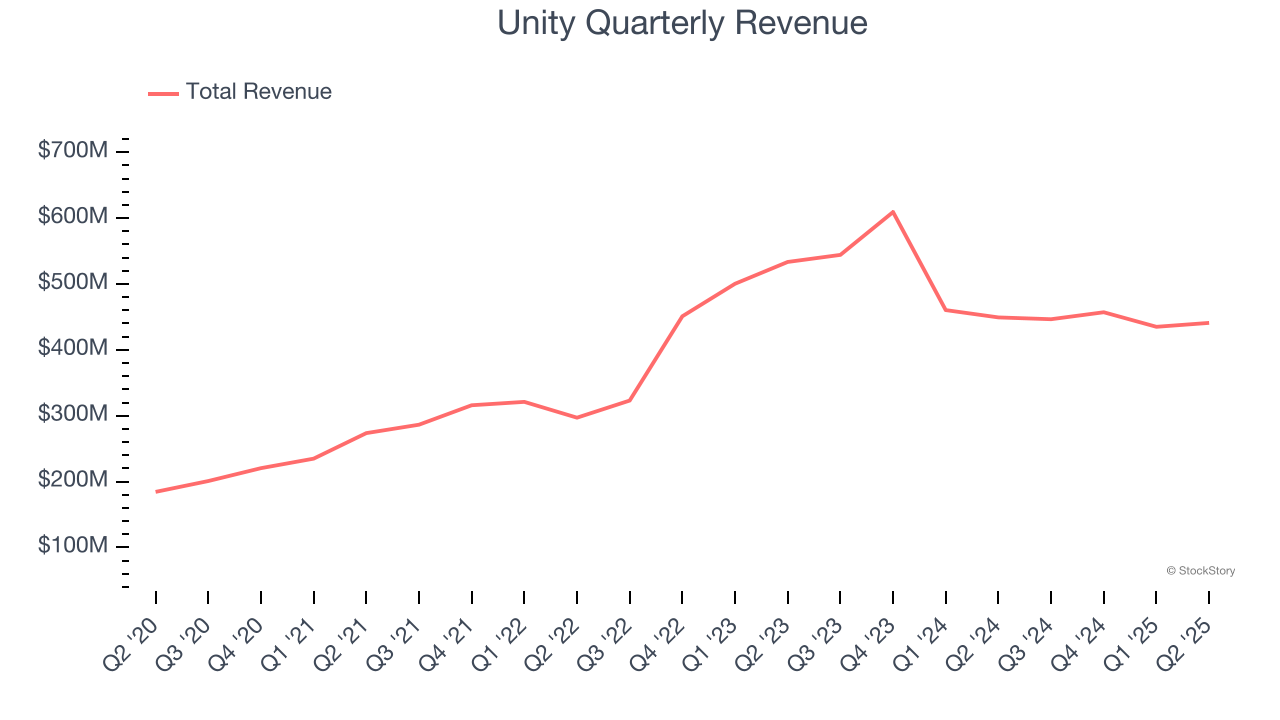
Game engine maker Unity (NYSE: U) reported Q2 CY2025 results exceeding the market’s revenue expectations, but sales fell by 1.9% year on year to $440.9 million. On the other hand, next quarter’s revenue guidance of $445 million was less impressive, coming in 0.6% below analysts’ estimates. Its non-GAAP profit of $0.18 per share was 22% above analysts’ consensus estimates.
Is now the time to buy Unity? Find out by accessing our full research report, it’s free.
Unity (U) Q2 CY2025 Highlights:
- Revenue: $440.9 million vs analyst estimates of $427.5 million (1.9% year-on-year decline, 3.1% beat)
- Adjusted EPS: $0.18 vs analyst estimates of $0.15 (22% beat)
- Adjusted EBITDA: $90.5 million vs analyst estimates of $77.49 million (20.5% margin, 16.8% beat)
- Revenue Guidance for Q3 CY2025 is $445 million at the midpoint, below analyst estimates of $447.6 million
- EBITDA guidance for Q3 CY2025 is $92.5 million at the midpoint, below analyst estimates of $93.25 million
- Operating Margin: -26.9%, up from -28.8% in the same quarter last year
- Free Cash Flow Margin: 28.7%, up from 1.7% in the previous quarter
- Market Capitalization: $14.11 billion
"We believe the second quarter of 2025 will be remembered as an inflection point in the Unity story, where our commitment to accelerating product innovation and delivering for our customers translated to markedly better performance," said Matt Bromberg, President and CEO of Unity.
Company Overview
Started as a game studio by three friends in a Copenhagen apartment, Unity (NYSE: U) is a software as a service platform that makes it easier to develop and monetize new games and other visual digital experiences.
Revenue Growth
A company’s long-term sales performance can indicate its overall quality. Any business can put up a good quarter or two, but the best consistently grow over the long haul. Over the last three years, Unity grew its sales at a 13.4% compounded annual growth rate. Although this growth is acceptable on an absolute basis, it fell short of our standards for the software sector, which enjoys a number of secular tailwinds.

This quarter, Unity’s revenue fell by 1.9% year on year to $440.9 million but beat Wall Street’s estimates by 3.1%. Company management is currently guiding for flat sales next quarter.
Looking further ahead, sell-side analysts expect revenue to grow 4.3% over the next 12 months, a deceleration versus the last three years. This projection doesn't excite us and indicates its products and services will see some demand headwinds.
Today’s young investors won’t have read the timeless lessons in Gorilla Game: Picking Winners In High Technology because it was written more than 20 years ago when Microsoft and Apple were first establishing their supremacy. But if we apply the same principles, then enterprise software stocks leveraging their own generative AI capabilities may well be the Gorillas of the future. So, in that spirit, we are excited to present our Special Free Report on a profitable, fast-growing enterprise software stock that is already riding the automation wave and looking to catch the generative AI next.
Customer Acquisition Efficiency
The customer acquisition cost (CAC) payback period represents the months required to recover the cost of acquiring a new customer. Essentially, it’s the break-even point for sales and marketing investments. A shorter CAC payback period is ideal, as it implies better returns on investment and business scalability.
Unity’s recent customer acquisition efforts haven’t yielded returns as its CAC payback period was negative this quarter, meaning its incremental sales and marketing investments outpaced its revenue. The company’s inefficiency indicates it operates in a highly competitive environment where there is little differentiation between Unity’s products and its peers.
Key Takeaways from Unity’s Q2 Results
We were impressed by how significantly Unity blew past analysts’ EPS and EBITDA expectations this quarter. We were also happy its revenue outperformed Wall Street’s estimates. On the other hand, its revenue and EBITDA guidance for next quarter fell slightly short of Wall Street’s estimates. Overall, this print was mixed but still had some key positives. The market seemed to be hoping for more, and the stock traded down 4.9% to $32.30 immediately after reporting.
Should you buy the stock or not? When making that decision, it’s important to consider its valuation, business qualities, as well as what has happened in the latest quarter. We cover that in our actionable full research report which you can read here, it’s free.







